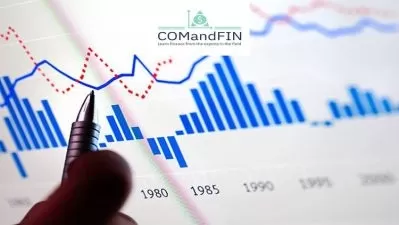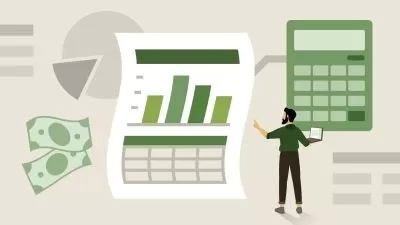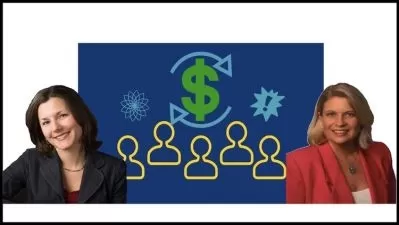Financial Accounting-Adjusting Entries & Financial Statement
Robert (Bob) Steele
9:21:38
Description
Master Adjusting Entries & Financial Statements: A Comprehensive Guide for Accurate Accounting and Reporting
What You'll Learn?
- Identify the components of the accounting cycle and analyze the role of adjusting journal entries within it.
- Classify and categorize the four main types of adjusting journal entries: prepaid expenses, unearned revenue, accrued expenses, and accrued revenue.
- Apply the appropriate adjusting journal entries for each type and construct examples to illustrate their impact.
- Evaluate the distinguishing characteristics of adjusting journal entries and differentiate them from regular journal entries.
- Organize and manage data effectively using an adjusting journal entries worksheet.
- Analyze and interpret common adjusting journal entries encountered in financial accounting.
- Critically assess the purpose and significance of reversing entries and analyze common examples.
- Construct accurate balance sheets, income statements, and statements of equity based on the adjusted trial balance.
- Examine the interconnectedness of the balance sheet, income statement, and statement of equity in financial reporting.
- Demonstrate a thorough understanding of accrual concepts and their application in the adjusting process.
- Apply problem-solving skills through multiple-choice practice questions to reinforce comprehension and analytical thinking.
- Utilize mathematical reasoning to solve short calculation practice questions related to adjusting entries.
Who is this for?
What You Need to Know?
More details
DescriptionThis comprehensive course covers the fundamental concepts and processes of adjusting entries, posting them to a worksheet, creating financial statements from an adjusted trial balance, and understanding reversing entries.
The adjusting entry process is often misunderstood, as it is commonly assumed to be a means of correcting accounting errors. However, adjusting entries are an integral part of the accounting cycle and are built into the accounting system. They help us recognize revenue and expenses based on accrual concepts and timing differences.
In this course, we will learn to enter adjusting entries as of the end of the accounting period. These entries have both balance sheet and income statement components. Once the adjusting entries are complete, we will use the adjusted trial balance to generate financial statements, including the balance sheet, income statement, and statement of equity.
To enhance your learning experience, this course provides valuable resources, including downloadable PDF files, Excel practice files, multiple-choice practice questions, short calculation practice questions, and discussion questions. These resources will supplement your understanding and allow for practical application.
Your instructor for this course is a Certified Public Accountant (CPA) and Chartered Global Management Accountant (CGMA) with extensive technical accounting experience. He has a Master's degree in Taxation and is a certified post-secondary instructor (CPS) with expertise in curriculum development. You will benefit from his practical insights and instructional expertise.
Topics covered in this course include the adjusting process, posting adjusting entries to a worksheet, financial statement creation, and reversing entries. We will explore the components of the worksheet and understand how adjusting entries impact accrual accounting.
By the end of this course, you will be able to effectively navigate the accounting cycle, identify the different categories of adjusting entries, create financial statements from an adjusted trial balance, and understand the relationship between the balance sheet, income statement, and statement of equity.
Join us on this learning journey as we delve into Financial Accounting, Adjusting Entries & Financial Statements. Get ready for an engaging and educational experience. Don't miss out on this opportunity for continuing professional education (CPE).
Who this course is for:
- Accounting Students: This course serves as a valuable resource for accounting students at the undergraduate or graduate level who want to enhance their understanding of adjusting entries and financial statement preparation. It provides a practical application of accounting theory and concepts, preparing students for real-world accounting scenarios.
- Accounting Professionals: The course is also suitable for professionals already working in the accounting field who want to deepen their knowledge of adjusting entries and financial statement analysis. It serves as a refresher course and helps professionals stay updated with best practices in financial accounting.
- Bookkeepers and Financial Analysts: Bookkeepers and financial analysts who are responsible for recording financial transactions and analyzing financial statements can benefit from this course. It equips them with the necessary skills to accurately record adjusting entries and interpret financial information effectively.
- Small Business Owners and Entrepreneurs: Small business owners and entrepreneurs who manage their own bookkeeping or want to have a better understanding of financial statements will find this course valuable. It empowers them to make informed decisions based on accurate financial information.
- Anyone Interested in Financial Accounting: Individuals with a general interest in financial accounting, whether for personal knowledge or career development purposes, can enroll in this course. It provides a comprehensive introduction to adjusting entries and financial statements, making it accessible to learners from various backgrounds.
This comprehensive course covers the fundamental concepts and processes of adjusting entries, posting them to a worksheet, creating financial statements from an adjusted trial balance, and understanding reversing entries.
The adjusting entry process is often misunderstood, as it is commonly assumed to be a means of correcting accounting errors. However, adjusting entries are an integral part of the accounting cycle and are built into the accounting system. They help us recognize revenue and expenses based on accrual concepts and timing differences.
In this course, we will learn to enter adjusting entries as of the end of the accounting period. These entries have both balance sheet and income statement components. Once the adjusting entries are complete, we will use the adjusted trial balance to generate financial statements, including the balance sheet, income statement, and statement of equity.
To enhance your learning experience, this course provides valuable resources, including downloadable PDF files, Excel practice files, multiple-choice practice questions, short calculation practice questions, and discussion questions. These resources will supplement your understanding and allow for practical application.
Your instructor for this course is a Certified Public Accountant (CPA) and Chartered Global Management Accountant (CGMA) with extensive technical accounting experience. He has a Master's degree in Taxation and is a certified post-secondary instructor (CPS) with expertise in curriculum development. You will benefit from his practical insights and instructional expertise.
Topics covered in this course include the adjusting process, posting adjusting entries to a worksheet, financial statement creation, and reversing entries. We will explore the components of the worksheet and understand how adjusting entries impact accrual accounting.
By the end of this course, you will be able to effectively navigate the accounting cycle, identify the different categories of adjusting entries, create financial statements from an adjusted trial balance, and understand the relationship between the balance sheet, income statement, and statement of equity.
Join us on this learning journey as we delve into Financial Accounting, Adjusting Entries & Financial Statements. Get ready for an engaging and educational experience. Don't miss out on this opportunity for continuing professional education (CPE).
Who this course is for:
- Accounting Students: This course serves as a valuable resource for accounting students at the undergraduate or graduate level who want to enhance their understanding of adjusting entries and financial statement preparation. It provides a practical application of accounting theory and concepts, preparing students for real-world accounting scenarios.
- Accounting Professionals: The course is also suitable for professionals already working in the accounting field who want to deepen their knowledge of adjusting entries and financial statement analysis. It serves as a refresher course and helps professionals stay updated with best practices in financial accounting.
- Bookkeepers and Financial Analysts: Bookkeepers and financial analysts who are responsible for recording financial transactions and analyzing financial statements can benefit from this course. It equips them with the necessary skills to accurately record adjusting entries and interpret financial information effectively.
- Small Business Owners and Entrepreneurs: Small business owners and entrepreneurs who manage their own bookkeeping or want to have a better understanding of financial statements will find this course valuable. It empowers them to make informed decisions based on accurate financial information.
- Anyone Interested in Financial Accounting: Individuals with a general interest in financial accounting, whether for personal knowledge or career development purposes, can enroll in this course. It provides a comprehensive introduction to adjusting entries and financial statements, making it accessible to learners from various backgrounds.
User Reviews
Rating
Robert (Bob) Steele
Instructor's Courses
Udemy
View courses Udemy- language english
- Training sessions 88
- duration 9:21:38
- English subtitles has
- Release Date 2023/10/04
















